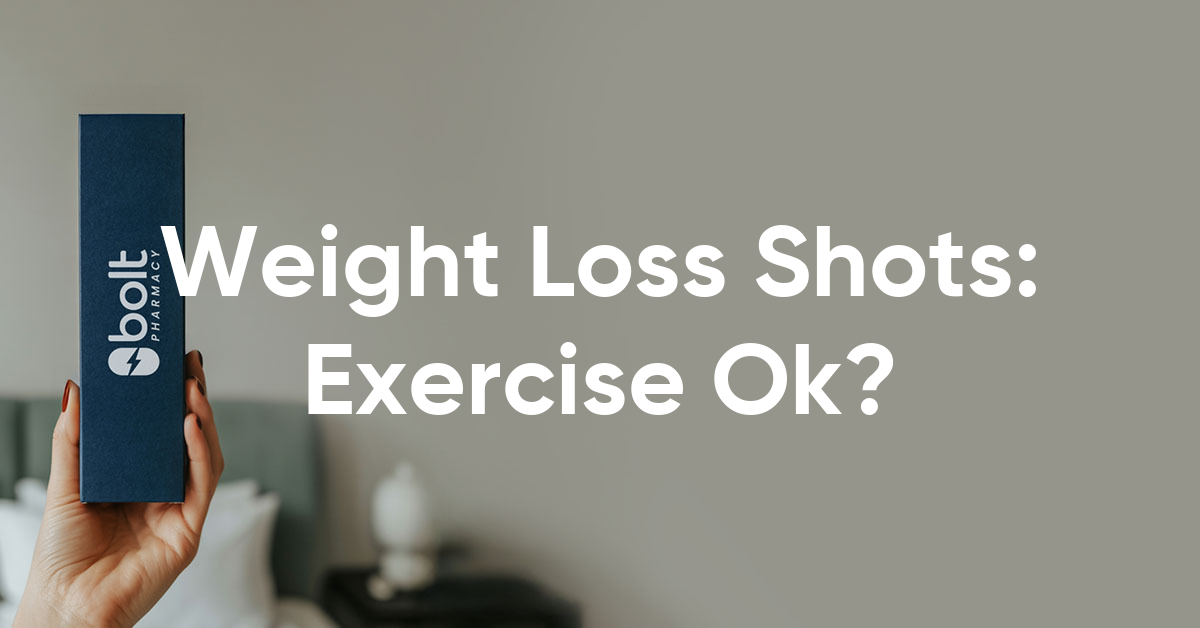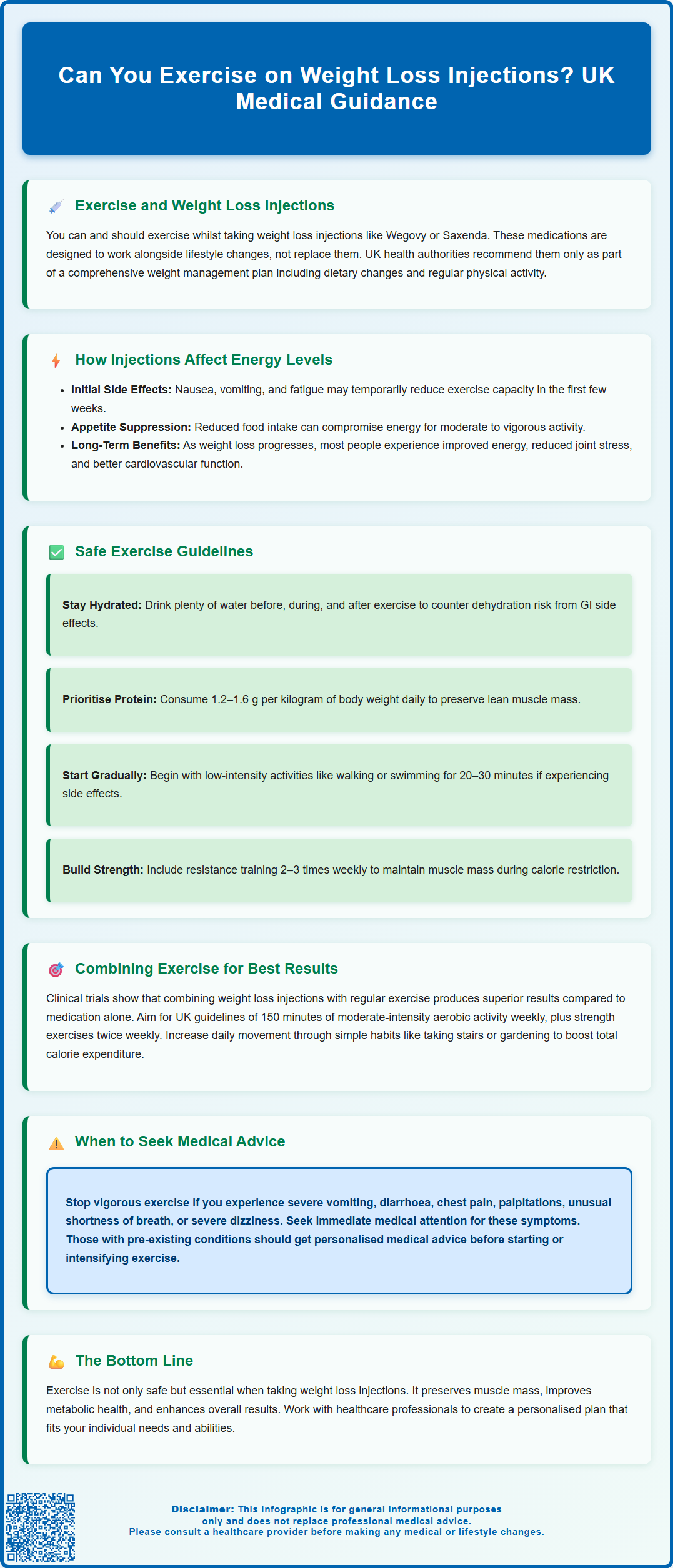Mounjaro®
Dual-agonist support that helps curb appetite, hunger, and cravings to drive substantial, sustained weight loss.
- ~22.5% average body weight loss
- Significant weight reduction
- Improves blood sugar levels
- Clinically proven weight loss

Can you exercise on weight loss injections? Yes, physical activity is not only safe but actively encouraged whilst taking weight loss medications such as semaglutide (Wegovy) or liraglutide (Saxenda). These glucagon-like peptide-1 (GLP-1) receptor agonists are designed to work alongside lifestyle modifications, including regular exercise and dietary changes, rather than as standalone treatments. NICE guidance emphasises that pharmacological interventions for obesity should form part of a comprehensive weight management plan incorporating behavioural strategies for diet and physical activity. Understanding how these medications interact with exercise, and knowing when to adjust your routine, is essential for safe and effective weight management.
Summary: Yes, you can exercise whilst taking weight loss injections, and physical activity is actively encouraged as part of a comprehensive weight management programme alongside these medications.
Yes, you can exercise whilst taking weight loss injections, and in fact, physical activity is generally encouraged as part of a comprehensive weight management programme. Weight loss medications such as semaglutide (Wegovy) and liraglutide (Saxenda) are designed to work alongside lifestyle modifications, including regular exercise and dietary changes, rather than as standalone treatments.
These medications, known as glucagon-like peptide-1 (GLP-1) receptor agonists, work by mimicking a naturally occurring hormone that regulates appetite and blood sugar levels. They slow gastric emptying, increase feelings of fullness, and reduce hunger signals to the brain. The Medicines and Healthcare products Regulatory Agency (MHRA) has approved these medications for weight management in adults with a body mass index (BMI) of 30 kg/m² or above, or 27 kg/m² with weight-related comorbidities.
NICE recommends these medications for use within specialist weight management services when specific criteria are met. The guidance emphasises that pharmacological interventions for obesity should be prescribed only as part of an overall plan for managing obesity in adults, which includes strategies for changing behaviour related to diet and physical activity.
Exercise remains a cornerstone of sustainable weight loss and metabolic health, offering benefits beyond the scale including improved cardiovascular fitness, enhanced insulin sensitivity, better mood, and preservation of lean muscle mass during weight reduction.
It's worth noting that GLP-1 medications can cause a modest increase in resting heart rate. While this is usually not a barrier to exercise, some individuals may experience side effects during the initial weeks of treatment that could temporarily affect their exercise tolerance. Understanding how these medications interact with physical activity, and knowing when to modify your routine, is essential for safe and effective weight management.
Weight loss injections can influence your energy levels and exercise capacity through several mechanisms, particularly during the titration phase when your body is adjusting to the medication. The most common side effects of GLP-1 receptor agonists include nausea, vomiting, diarrhoea, and constipation, which affect many users to varying degrees. These gastrointestinal symptoms are typically most pronounced during the initial weeks of treatment and when doses are increased, with titration periods lasting up to 16 weeks for semaglutide (Wegovy) and 5 weeks for liraglutide (Saxenda).
These side effects can lead to reduced caloric intake and potential dehydration, both of which may temporarily diminish your energy levels and exercise performance. Additionally, the appetite-suppressing effects of these medications mean you may naturally consume fewer calories than usual. Whilst this calorie deficit is intended for weight loss, inadequate nutrition—particularly insufficient protein and carbohydrate intake—can compromise your ability to sustain moderate to vigorous physical activity.
Some patients report feeling fatigued or lethargic during the early stages of treatment, though this often improves as the body adapts. This fatigue may relate to the rapid dietary changes, altered glucose metabolism, or the gastrointestinal effects of the medication. Conversely, as weight loss progresses, many individuals experience improved energy levels, reduced joint stress, and enhanced cardiovascular function, which can actually improve exercise capacity over time.
It's important to note that while these medications do not directly impair muscle function, they can increase resting heart rate by a few beats per minute. The temporary reduction in exercise tolerance is generally related to side effects and caloric restriction rather than any direct pharmacological effect on muscle tissue. Monitoring your response and adjusting exercise intensity accordingly during the initial treatment period is advisable.

When beginning or continuing an exercise programme whilst taking weight loss injections, several safety considerations should guide your approach. First and foremost, ensure adequate hydration before, during, and after physical activity. The gastrointestinal side effects of GLP-1 medications can increase the risk of dehydration, particularly if you experience vomiting or diarrhoea. Aim to drink water regularly throughout the day, and consider electrolyte replacement if you're engaging in prolonged or intense exercise.
Nutritional adequacy is equally important. Despite reduced appetite, you must consume sufficient protein to preserve lean muscle mass during weight loss. Many dietitians suggest approximately 1.2–1.6 g per kilogram of body weight daily, though this should be individualised and may need adjustment for those with kidney disease. Ensure you're eating balanced meals that include complex carbohydrates for energy, particularly if you exercise regularly. Some patients find that exercising before their injection or during periods when nausea is minimal improves tolerance, though this is based on personal experience rather than clinical evidence.
Regarding exercise intensity, adopt a gradual, progressive approach:
Start conservatively: If you're new to exercise or experiencing significant side effects, begin with low-intensity activities such as walking, swimming, or gentle cycling for 20–30 minutes.
Listen to your body: Reduce intensity or duration if you feel dizzy, excessively fatigued, or nauseous during exercise.
Progress gradually: As your body adapts to the medication and side effects diminish, progressively increase exercise duration and intensity.
Include resistance training: Incorporate strength training 2–3 times weekly to preserve muscle mass, which is particularly important during caloric restriction.
The UK Chief Medical Officers' guidelines recommend that adults aim for at least 150 minutes of moderate-intensity aerobic activity or 75 minutes of vigorous-intensity activity weekly, plus strength exercises on two or more days. These targets remain appropriate for those on weight loss medications, though the timeline for achieving them may need adjustment based on individual tolerance and baseline fitness levels.
The synergistic effect of combining weight loss injections with regular exercise produces superior outcomes compared to either intervention alone. Clinical trials of semaglutide (STEP programme) and liraglutide (SCALE trials) have demonstrated that participants who engage in structured lifestyle interventions—including regular physical activity—achieve greater weight loss and better metabolic improvements than those relying on medication alone.
Exercise offers several benefits that complement the pharmacological effects of GLP-1 receptor agonists. Resistance training is particularly valuable as it helps preserve lean muscle mass during weight loss. Research suggests that without resistance exercise, a significant proportion of weight lost may come from muscle tissue rather than fat. Maintaining muscle mass is crucial for sustaining metabolic rate, functional capacity, and long-term weight maintenance. Aim for full-body resistance training sessions twice weekly, targeting major muscle groups with exercises such as squats, lunges, press-ups, and rows.
Cardiovascular exercise enhances the metabolic benefits of weight loss medications by improving insulin sensitivity, reducing cardiovascular risk factors, and increasing energy expenditure. Activities such as brisk walking, cycling, swimming, or dancing can be adapted to your fitness level and preferences. High-intensity interval training (HIIT) may offer time-efficient benefits once you've established a baseline fitness level and side effects have stabilised.
Beyond structured exercise, increasing non-exercise activity thermogenesis (NEAT)—the energy expended during daily activities—can significantly contribute to weight loss. Simple strategies include taking the stairs, parking further away, gardening, or using a standing desk. These activities accumulate throughout the day and can substantially increase total energy expenditure.
For optimal results, work with healthcare professionals to develop a personalised plan. NICE recommends that weight management programmes include ongoing support, behavioural strategies, and regular monitoring. Many NHS weight management services offer multidisciplinary support including dietitians, physiotherapists, and behavioural psychologists who can help tailor an exercise programme to your individual needs and capabilities.
Whilst exercise is generally safe and beneficial during weight loss injection therapy, certain situations warrant caution or temporary cessation of physical activity. If you experience severe gastrointestinal symptoms—particularly persistent vomiting or diarrhoea—that prevent adequate fluid and food intake, postpone vigorous exercise until symptoms improve. Dehydration combined with intense physical activity can lead to electrolyte imbalances, dizziness, and increased risk of injury.
Contact your GP or prescribing clinician if you experience any of the following during or after exercise whilst taking weight loss medications:
Severe or persistent abdominal pain, which could indicate pancreatitis (a rare but serious side effect of GLP-1 medications). If you suspect pancreatitis, stop taking the medication and seek urgent medical care
Chest pain, palpitations, or unusual shortness of breath
Severe dizziness, fainting, or near-fainting episodes
Signs of dehydration including dark urine, extreme thirst, or reduced urination
Unexplained muscle weakness or cramping that doesn't resolve with rest
Symptoms of hypoglycaemia (low blood sugar)—shakiness, confusion, sweating, or rapid heartbeat. This is uncommon with GLP-1 medications alone but more likely if you're also taking insulin or sulfonylureas for diabetes
Individuals with pre-existing medical conditions should seek personalised advice before starting or intensifying an exercise programme. This includes those with cardiovascular disease, uncontrolled hypertension, diabetic complications (particularly retinopathy or neuropathy), significant joint problems, or a history of eating disorders. Your GP may recommend a cardiac assessment or referral to a physiotherapist or NHS exercise referral scheme.
If you're losing weight very rapidly (more than 0.5–1 kg per week consistently), discuss this with your healthcare provider. Whilst weight loss injections are effective, excessively rapid weight loss combined with intense exercise may increase the risk of gallstones, nutritional deficiencies, and excessive muscle loss. Your prescriber may need to adjust your medication dose or provide additional nutritional support.
Remember that weight loss medications are prescribed as part of a comprehensive, medically supervised programme. Regular follow-up appointments allow monitoring of your progress, side effects, and overall health, ensuring that your exercise routine remains safe and effective throughout your weight management journey. Report any suspected side effects to the MHRA Yellow Card scheme (yellowcard.mhra.gov.uk).
Weight loss injections may temporarily reduce energy levels during the initial titration phase due to gastrointestinal side effects and reduced caloric intake. However, as your body adapts and weight loss progresses, many individuals experience improved energy levels and enhanced exercise capacity.
A combination of resistance training (twice weekly) to preserve muscle mass and cardiovascular exercise (150 minutes moderate-intensity weekly) produces optimal results. Start conservatively and progress gradually based on your tolerance and fitness level.
Postpone vigorous exercise if you experience severe gastrointestinal symptoms, dehydration, or persistent vomiting. Seek immediate medical advice if you develop severe abdominal pain, chest pain, palpitations, or signs of pancreatitis during or after exercise.
The health-related content published on this site is based on credible scientific sources and is periodically reviewed to ensure accuracy and relevance. Although we aim to reflect the most current medical knowledge, the material is meant for general education and awareness only.
The information on this site is not a substitute for professional medical advice. For any health concerns, please speak with a qualified medical professional. By using this information, you acknowledge responsibility for any decisions made and understand we are not liable for any consequences that may result.
Lorem ipsum dolor sit amet, consectetur adipiscing elit, sed do eiusmod tempor incididunt ut labore et dolore magna aliqua. Ut enim ad minim veniam, quis nostrud exercitation ullamco laboris nisi ut aliquip ex ea commodo consequat. Duis aute irure dolor in reprehenderit in voluptate velit esse cillum dolore eu fugiat nulla pariatur.
Block quote
Ordered list
Unordered list
Bold text
Emphasis
Superscript
Subscript